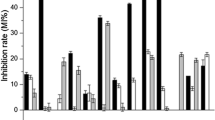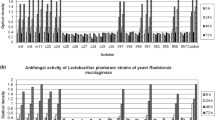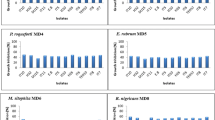Abstract
The aim of this research was to investigate the antifungal potential of lactic acid bacteria (LAB) isolated from Turkish spontaneous sourdough collected in summer and winter seasons from 25 different small bakeries in Trabzon, Giresun, Ordu, and Samsun. Lactic acid bacteria (933 isolates) were screened for inhibition of three common food spoilage molds (Aspergillus flavus, Aspergillus niger, and Penicillium expansum). Eight LAB isolates identified as Weissella cibaria 908, Lactiplantibacillus plantarum subsp. plantarum 2114, Leuconostoc pseudomesenteroides 2619, L. plantarum subsp. plantarum 2702, Fructilactobacillus sanfranciscensis 2709, Levilactobacillus brevis 2216Y, L. pentosus Y118, and L. plantarum subsp. plantarum Y201 by 16 S rRNA sequencing, which were found to have high antifungal activity against all the test molds. The antifungal activity of cell free supernatants from LAB isolates was not altered after thermal treatment and proteolytic enzyme proteinase K. The cell free supernatants obtained from LAB showed a high antifungal effect against molds with inhibition zone diameter up to 20 mm at pH 3.0, but no inhibitory activity was determined after pH neutralization. Moreover, all cell free suspension samples were able to maintain their efficacy up to a 1:4 dilution. The antifungal activity of supernatants was mostly related to organic acid content, especially lactic acid ranged from 4.33 to 8.41 g/L. The results indicated that eight bacterial isolates obtained from spontaneous Turkish sourdough could constitute biopreservative cultures, which may be used in food industry.





Similar content being viewed by others
Data Availability
All data generated or analyzed during this study are included in this published article (and its supplementary information files).
Code Availability
Not applicable.
References
Cortes-Zavaleta O, Lopez-Malo A, Hernandez-Mendoza A, Garcia HS (2014) Antifungal activity of lactobacilli and its relationship with 3-phenyllactic acid production. Int J Food Microbiol 173:30–35. https://doi.org/10.1016/j.ijfoodmicro.2013.12.016
Muhialdin BJ, Hassan Z, Sadon S (2011) Antifungal activity of Lactobacillus fermentum Te007, Pediococcus pentosaceus Te010, Lactobacillus pentosus G004, and L. paracasi D5 on selected foods. J Food Sci 76(7):493–499. https://doi.org/10.1111/j.1750-3841.2011.02292.x
Fernandez B, Vimont A, Desfossés-Foucault É, Daga M, Arora G, Fliss I (2017) Antifungal activity of lactic and propionic acid bacteria and their potential as protective culture in cottage cheese. Food Control 78:350–356. https://doi.org/10.1016/j.foodcont.2017.03.007
Delavenne E, Mounier J, Deniel F, Barbier G, Le Blay G (2012) Biodiversity of antifungal lactic acid bacteria isolated from raw milk samples from cow, ewe and goat over one-year period. Int J Food Microbiol 155(3):185–190. https://doi.org/10.1016/j.ijfoodmicro.2012.02.003
Le Lay C, Mounier J, Vasseur V, Weill A, Le Blay G, Barbier G, Coton E (2016) In vitro and in situ screening of lactic acid bacteria and propionibacteria antifungal activities against bakery product spoilage molds. Food Control 60:247–255. https://doi.org/10.1016/j.foodcont.2015.07.034
Gerez CL, Torres MJ, Font de Valdez G, Rollán G (2013) Control of spoilage fungi by lactic acid bacteria. Biol Control 64(3):231–237. https://doi.org/10.1016/j.biocontrol.2012.10.009
Nazareth TM, Luz C, Torrijos R, Quiles JM, Luciano FB, Manes J, Meca G (2019) Potential application of lactic acid bacteria to reduce aflatoxin B1 and fumonisin B1 occurrence on corn kernels and corn ears. Toxins 12(1–16):21. https://doi.org/10.3390/toxins12010021
Le Lay C, Coton E, Le Blay G, Chobert JM, Haertle T, Choiset Y, Van Long NN, Meslet-Cladiere L, Mounier J (2016) Identification and quantification of antifungal compounds produced by lactic acid bacteria and propionibacteria. Int J Food Microbiol 239:79–85. https://doi.org/10.1016/j.ijfoodmicro.2016.06.020
Muhialdin BJ, Algboory HL, Kadum H, Mohammed NK, Saari N, Hassan Z, Meor Hussin AS (2020) Antifungal activity determination for the peptides generated by Lactobacillus plantarum TE10 against Aspergillus flavus in maize seeds. Food Control 109:106898. https://doi.org/10.1016/j.foodcont.2019.106898
Bartkiene E, Lele V, Ruzauskas M, Domig KJ, Starkute V, Zavistanaviciute P, Bartkevics V, Pugajeva I, Klupsaite D, Juodeikiene G, Mickiene R, Rocha JM (2020) Lactic acid bacteria isolation from spontaneous sourdough and their characterization including antimicrobial and antifungal properties evaluation. Microorganisms 8(1–20):64. https://doi.org/10.3390/microorganisms8010064
Matevosyan LA, Bazukyan IL, Trchounian AH (2020) Antifungal activity of lactic acid bacteria isolates and their associations: the effects of Ca and Mg divalent cations. Curr Microbiol 77(6):959–966. https://doi.org/10.1007/s00284-020-01897-5
Valerio F, Favilla M, De Bellis P, Sisto A, de Candia S, Lavermicocca P (2009) Antifungal activity of strains of lactic acid bacteria isolated from a semolina ecosystem against Penicillium roqueforti, Aspergillus niger and Endomyces fibuliger contaminating bakery products. Syst Appl Microbiol 32(6):438–448. https://doi.org/10.1016/j.syapm.2009.01.004
Fanche SAY, Tchokonthe ALW, DiguȚĂ CF, Kamdem SLS, Israel-Roming F, Matei F, Ngang J-JE (2020) Antifungal properties of lactic acid bacteria isolated from cocoa beans fermentation in the centre region of Cameroon. Rom Biotechnol Lett 25(2):1407–1417. https://doi.org/10.25083/rbl/25.2/1407.1417
Cheong EYL, Sandhu A, Jayabalan J, Le Kieu TT, Nhiep NT, My Ho HT, Zwielehner J, Bansal N, Turner MS (2014) Isolation of lactic acid bacteria with antifungal activity against the common cheese spoilage mould Penicillium commune and their potential as biopreservatives in cheese. Food Control 46:91–97. https://doi.org/10.1016/j.foodcont.2014.05.011
Yildirim-Mavis C, Yilmaz MT, Dertli E, Arici M, Ozmen D (2019) Non-linear rheological (LAOS) behavior of sourdough-based dough. Food Hydrocolloids 96:481–492. https://doi.org/10.1016/j.foodhyd.2019.05.055
Alkay Z, Kilmanoğlu H, Durak MZ (2020) Prevention of sourdough bread mould spoliage by antifungal lactic acid bacteria fermentation. Eur J Sci Technol 18:379–388. https://doi.org/10.31590/ejosat.646043
Corsetti A, Gobbetti M, Rossi J, Damiani P (1998) Antimould activity of sourdough lactic acid bacteria: identification of a mixture of organic acids produced by Lactobacillus sanfrancisco CB1. Appl Microbiol Biotechnol 50(2):253–256. https://doi.org/10.1007/s002530051285
Yurttas M (2018) Isolation, identification and determination industrial features of degrading gluten and phytate lactic acid bacterias from Trabzon sourdough. Doctoral Dissertation, University of Ondokuz Mayıs
Rouse S, Harnett D, Vaughan A, van Sinderen D (2008) Lactic acid bacteria with potential to eliminate fungal spoilage in foods. J Appl Microbiol 104(3):915–923. https://doi.org/10.1111/j.1365-2672.2007.03619.x
Magnusson J, Schnurer J (2001) Lactobacillus coryniformis subsp. coryniformis strain Si3 produces a broad-spectrum proteinaceous antifungal compound. Appl Environ Microbiol 67(1):1–5. https://doi.org/10.1128/AEM.67.1.1-5.2001
De Vuyst L, Schrijvers V, Paramithiotis S, Hoste B, Vancanneyt M, Swings J, Kalantzopoulos G, Tsakalidou E, Messens W (2002) The biodiversity of lactic acid bacteria in Greek traditional wheat sourdoughs is reflected in both composition and metabolite formation. Appl Environ Microbiol 68(12):6059–6069. https://doi.org/10.1128/AEM.68.12.6059-6069.2002
Kim OS, Cho YJ, Lee K, Yoon SH, Kim M, Na H, Park SC, Jeon YS, Lee JH, Yi H, Won S, Chun J (2012) Introducing EzTaxon-e: a prokaryotic 16S rRNA gene sequence database with phylotypes that represent uncultured species. Int J Syst Evol Microbiol 62(Pt 3):716–721. https://doi.org/10.1099/ijs.0.038075-0
Lind H, Jonsson H, Schnurer J (2005) Antifungal effect of dairy propionibacteria–contribution of organic acids. Int J Food Microbiol 98(2):157–165. https://doi.org/10.1016/j.ijfoodmicro.2004.05.020
Valerio F, Lavermicocca P, Pascale M, Visconti A (2004) Production of phenyllactic acid by lactic acid bacteria: an approach to the selection of strains contributing to food quality and preservation. FEMS Microbiol Lett 233(2):289–295. https://doi.org/10.1111/j.1574-6968.2004.tb09494.x
Yang Y, Bastos M, Chen KY (1993) Effects of osmotic stress and growth stage on cellular pH and polyphosphate metabolism in Neurospora crassa as studied by 31P nuclear magnetic resonance spectroscopy. Biochim Biophys Acta 1179(2):141–147. https://doi.org/10.1016/0167-4889(93)90135-C
Chen H, Ju H, Wang Y, Du G, Yan X, Cui Y, Yuan Y, Yue T (2021) Antifungal activity and mode of action of lactic acid bacteria isolated from kefir against Penicillium expansum. Food Control 130:108274. https://doi.org/10.1016/j.foodcont.2021.108274
Lavermicocca P, Valerio F, Evidente A, Lazzaroni S, Corsetti A, Gobbetti M (2000) Purification and characterization of novel antifungal compounds from the sourdough Lactobacillus plantarum strain 21B. Appl Environ Microbiol 66(9):4084–4090. https://doi.org/10.1128/AEM.66.9.4084-4090.2000
Saitou N, Nei M (1987) The neighbor-joining method: a new method for reconstructing phylogenetic trees. Mol Biol Evol 4:406–425. https://doi.org/10.1093/oxfordjournals.molbev.a040454
Gourama H, Bullerman LB (1997) Anti-aflatoxigenic activity of Lactobacillus casei pseudoplantarum. Int J Food Microbiol 34(2):131–143. https://doi.org/10.1016/S0168-1605(96)01176-2
Crowley S, Mahony J, van Sinderen D (2013) Broad-spectrum antifungal-producing lactic acid bacteria and their application in fruit models. Folia Microbiol 58(4):291–299. https://doi.org/10.1007/s12223-012-0209-3
Abouloifa H, Gaamouche S, Rokni Y, Hasnaoui I, Bellaouchi R, Ghabbour N, Karboune S, Brasca M, D’Hallewin G, Ben Salah R, Saalaoui E, Asehraou A (2021) Antifungal activity of probiotic Lactobacillus strains isolated from natural fermented green olives and their application as food bio-preservative. Biol Control 152:104450. https://doi.org/10.1016/j.biocontrol.2020.104450
Li H, Liu L, Zhang S, Cui W, Lv J (2012) Identification of antifungal compounds produced by Lactobacillus casei AST18. Curr Microbiol 65(2):156–161. https://doi.org/10.1007/s00284-012-0135-2
De Muynck C, Leroy AI, De Maeseneire S, Arnaut F, Soetaert W, Vandamme EJ (2004) Potential of selected lactic acid bacteria to produce food compatible antifungal metabolites. Microbiol Res 159(4):339–346. https://doi.org/10.1016/j.micres.2004.07.002
Ndagano D, Lamoureux T, Dortu C, Vandermoten S, Thonart P (2011) Antifungal activity of 2 lactic acid bacteria of the Weissella genus isolated from food. J Food Sci 76(6):305–311. https://doi.org/10.1111/j.1750-3841.2011.02257.x
Schwenninger SM, Lacroix C, Truttmann S, Jans CSC, Bigler L, Meile L (2008) Characterization of low-molecular-weight antiyeast metabolites produced by a food-protective Lactobacillus-Propionibacterium coculture. J Food Prot 71(12):1481–1487. https://doi.org/10.4315/0362-028X-71.12.2481
Garrote GL, Abraham AG, De Antoni GL (2000) Inhibitory power of kefir: the role of organic acids. J Food Prot 63(3):364–369. https://doi.org/10.4315/0362-028X-63.3.364
Gerez CL, Torino MI, Rollán G, Font de Valdez G (2009) Prevention of bread mould spoilage by using lactic acid bacteria with antifungal properties. Food Control 20(2):144–148. https://doi.org/10.1016/j.foodcont.2008.03.005
Dagnas S, Gauvry E, Onno B, Membre JM (2015) Quantifying effect of lactic, acetic, and propionic acids on growth of molds isolated from spoiled bakery products. J Food Prot 78(9):1689–1698. https://doi.org/10.4315/0362-028X.JFP-15-046
Acknowledgements
Part of this study was derived from the Ph.D. thesis of Esra Saraç Arsoy.
Funding
This work was and supported by the Ondokuz Mayıs University Research Foundation (BAP) Project (PYO.MUH.1901.16.007).
Author information
Authors and Affiliations
Contributions
ESA: software, investigation, data duration, writing—original draft, formal analysis. LBG: methodology, formal analysis, identification of LAB. AHÇ: conceptualization, project administration, supervision, writing—review & editing. All authors read and approved the final manuscript.
Corresponding author
Ethics declarations
Conflict of interest
The author declares that they have no conflict of interest.
Ethical Approval
Not applicable.
Consent to Participate
All authors had consent to participate in the study.
Consent for Publication
All authors have given consent for publication.
Additional information
Publisher's Note
Springer Nature remains neutral with regard to jurisdictional claims in published maps and institutional affiliations.
Supplementary Information
Below is the link to the electronic supplementary material.
Rights and permissions
About this article
Cite this article
Arsoy, E.S., Gül, L.B. & Çon, A.H. Characterization and Selection of Potential Antifungal Lactic Acid Bacteria Isolated From Turkish Spontaneous Sourdough. Curr Microbiol 79, 148 (2022). https://doi.org/10.1007/s00284-022-02839-z
Received:
Accepted:
Published:
DOI: https://doi.org/10.1007/s00284-022-02839-z




